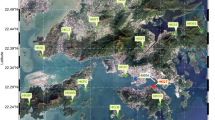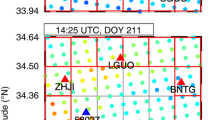Abstract
Water vapor information with highly spatial and temporal resolution can be acquired using Global Navigation Satellite System (GNSS) water vapor tomography technique. Usually, the targeted tomographic area is discretized into a number of voxels and the water vapor distribution can be reconstructed using a large number of GNSS signals which penetrate the entire tomographic area. Due to the influence of geographic distribution of receivers and geometric location of satellite constellation, many voxels located at the bottom and the side of research area are not crossed by signals, which would undermine the quality of tomographic result. To alleviate this problem, a novel, optimized approach of voxel division is here proposed which increases the number of voxels crossed by signals. On the vertical axis, a 3D water vapor profile is utilized, which is derived from radiosonde data for many years, to identify the maximum height of tomography space. On the horizontal axis, the total number of voxel crossed by signal is enhanced, based on the concept of non-uniform symmetrical division of horizontal voxels. In this study, tomographic experiments are implemented using GPS data from Hong Kong Satellite Positioning Reference Station Network, and tomographic result is compared with water vapor derived from radiosonde and European Center for Medium-Range Weather Forecasting (ECMWF). The result shows that the Integrated Water Vapour (IWV), RMS, and error distribution of the proposed approach are better than that of traditional method.


















Similar content being viewed by others
References
Adavi Z, Mashhadi-Hossainali M (2014) 4D tomographic reconstruction of the tropospheric wet refractivity using the concept of virtual reference station, case study: northwest of Iran. Meteorol Atmos Phys 126(3–4):193–205
Adeyemi B, Joerg S (2012) Analysis of water vapor over Nigeria using radiosonde and satellite data. J Appl Meteorol Climatol 51:1855–1866. doi:10.1175/JAMC-D-11-0119.1
Alber C, Ware R, Rocken C, Braun J (2000) Obtaining single path phase delays from GPS double differences. Geophys Res Lett 27(17):2661–2664
Bender M, Dick G, Ge M et al (2011) Development of a GNSS water vapour tomography system using algebraic reconstruction techniques. Adv Space Res 47:1704–1720. doi:10.1016/j.asr.2010.05.034
Bevis M, Businger S, Herring TA et al (1992) GPS meteorology: remote sensing of atmospheric water vapor using the global positioning system. J Geophys Res 97:15787–15801
Bi YM, Mao J, Li C (2006) Preliminary results of 4d water vapor tomography in the troposphere using GPS. Adv Atmos Sci 23:551–560. doi:10.1007/s00376-006-0551-y
Brenot HV, Ducrocq A, Walpersdorf C et al (2006) GPS zenith delay sensitivity evaluated from high-resolution numerical weather prediction simulations of the 8–9 September 2002 flash flood over southeastern France. J Geophys Res 111:D15105. doi:10.1029/2004JD005726
Champollion C, Flamant C, Bock O et al (2009) Mesoscale GPS tomography applied to the 12 June 2002 convective initiation event of IHOP 2002. Q J R Meteorol Soc 135:645–662
Champollion C, Masson F, Bouin MN et al (2005) GPS water vapour tomography:preliminary results from the ESCOMPTE field experiment. Atmos res 74(1):253–274
Chen BY, Liu ZZ (2014) Voxel-optimized regional water vapor tomography and comparison with radiosonde and numerical weather model. J Geod 88:391–703. doi:10.1007/s00190-014-0715-y
Elósegui P, Ruis A, Davis JL, Ruffini G, Keihm SJ, Bürki B, Kruse LP (1998) An experiment for estimation of the spatial and temporal variations of water vapor using GPS data. Phys Chem Earth 23:125–130
Flores A, Ruffini G, Rius A (2000) 4D tropospheric tomography using GPS slant wet delays. Ann Geophys 18:223–234. doi:10.1007/s00585-000-0223-7
Herring TA, King RW, McClusky SC (2010) Documentation of the GAMIT GPS Analysis Software release 10.4. Department of Earth and Planetary Sciences, Massachusetts Institute of Technology, Cambridge, Massachusetts
Liu YX, Chen YQ, Liu JN (2001) Determination of weighted mean tropospheric temperature using ground meteorological measurements. Geospatial Inf Sci 4(1):14–18
Liu ZZ, Wong MS, Nichol J, Chan PW (2013) A multi-sensor study of water vapour from radiosonde, MODIS and AERONET: a case study of Hong Kong. Int J Climatol 33:109–120. doi:10.1002/joc.3412
Mendes VB (1999) Modeling the neutral-atmosphere propagation delay in radiometric space technique. PhD dissertation, University of New Brunswick, Frederiction, New Brunswick, Canada
Mohanakumar K (2008) Structure and composition of the lower and middle atmosphere. Stratosphere Troposphere Interactions:An Introduction, Springer, Netherlands p 1–53
Niell AE, Coster AJ, Solheim FS et al (2001) Comparison of measurements of atmospheric wet delay by radiosonde, water vapor radiometer, GPS, and VLBI. J Atmos Ocean Technol 18:830–850
Notarpietro R, Cucca M, Gabella M et al (2011) Tomographic reconstruction of wet and total refractivity fields from GNSS receiver networks. Adv Space Res 47:898–912. doi:10.1016/j.asr.1012.12.025
Perler D, Geiger A, Hurter F (2011) 4D GPS water vapour tomography: New parameterized approaches. J Geophys Res 85:539–550
Ran BY, Ge WZ (1997) Singular value decomposition method compared with damping least square method. Geophys Comput Technol 1:46–49
Rocken C, Hove TV, Johnson J, Solheim F, Ware R, Bevis M, Businger S (1995) GPS/STORM-GPS sensing of atmospheric water vapor for meteorology. J Atmos Ocean Technol 12(3):468–478
Rohm W, Bosy J (2009) Local tomography troposphere model over mountains area. Atmos Res 93:777–783. doi:10.1016/j.atmosres.2009.03.013
Rohm W, Zhang K, Bosy J (2014) Limited constraint, robust Kalman filtering for GNSS troposphere tomography. Atmos Meas Tech 7(5):1475–1486
Saastamoinen J (1972) Atmospheric correction for the troposphere and stratosphere in radio ranging satellites. The use of artificial satellites for geodesy, p 247–251
Skone S, Hoyle V (2005) Troposphere modeling in a regional GPS network. J Glob Position Syst 4:230–239
Song S, Zhu W, Ding J, Peng J (2006) 3D water vapor tomography with Shanghai GPS network to improve forecasted moisture field. Chin Sci Bull 51:607–614
Troller M, Bürki B, Cocard M, Geiger A, Kahle H-G (2002) 3-D refractivity field from GPS double difference tomography. Geophys Res Lett 29:2149–2152
Wan R (2014) Research progress of the unconventional observing technology and the data used in the study of rainstorm in China. Adv Meteorol Sci Technol 4:24–35
Wang JK, Han SQ, Bian H et al (2014) Characteristics of the three-dimensional GPS tomography water vapor field during the rainstorm. Acta Sci Nat Univ Pekin 50:1053–1064
Yao YB, Zhao QZ, Zhang B (2016) A method to improve the utilization of GNSS observation for water vapor tomography. Ann Geophys 34:143–152
Acknowledgments
The authors would like to thank IGAR for providing access to the web-based IGAR data and ECMWF for providing grids data of temperature, relative humidity and so on. The Lands Department of HKSAR is also acknowledged for providing GPS data from the Hong Kong Satellite Positioning Reference Station Network (SatRef) and rainfall information. This research was supported by the National Natural Science Foundation of China (41174012).
Author information
Authors and Affiliations
Corresponding author
Additional information
Responsible Editor: R. Roebeling.
Rights and permissions
About this article
Cite this article
Yao, Y., Zhao, Q. A novel, optimized approach of voxel division for water vapor tomography. Meteorol Atmos Phys 129, 57–70 (2017). https://doi.org/10.1007/s00703-016-0450-4
Received:
Accepted:
Published:
Issue Date:
DOI: https://doi.org/10.1007/s00703-016-0450-4




